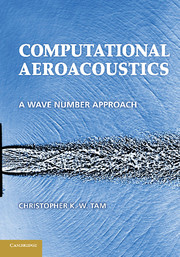Book contents
- Frontmatter
- Contents
- Preface
- 1 Finite Difference Equations
- 2 Spatial Discretization in Wave Number Space
- 3 Time Discretization
- 4 Finite Difference Scheme as Dispersive Waves
- 5 Finite Difference Solution of the Linearized Euler Equations
- 6 Radiation, Outflow, and Wall Boundary Conditions
- 7 The Short Wave Component of Finite Difference Schemes
- 8 Computation of Nonlinear Acoustic Waves
- 9 Advanced Numerical Boundary Treatments
- 10 Time-Domain Impedance Boundary Condition
- 11 Extrapolation and Interpolation
- 12 Multiscales Problems
- Chapter 13 Complex Geometry
- 14 Continuation of a Near-Field Acoustic Solution to the Far Field
- 15 Design of Computational Aeroacoustic Codes
- Appendix A Fourier and Laplace Transforms
- Appendix B The Method of Stationary Phase
- Appendix C The Method of Characteristics
- Appendix D Diffusion Equation
- Appendix E Accelerated Convergence to Steady State
- Appendix F Generation of Broadband Sound Waves with a Prescribed Spectrum by an Energy-Conserving Discretization Method
- Appendix G Sample Computer Programs
- References
- Index
6 - Radiation, Outflow, and Wall Boundary Conditions
Published online by Cambridge University Press: 05 October 2012
- Frontmatter
- Contents
- Preface
- 1 Finite Difference Equations
- 2 Spatial Discretization in Wave Number Space
- 3 Time Discretization
- 4 Finite Difference Scheme as Dispersive Waves
- 5 Finite Difference Solution of the Linearized Euler Equations
- 6 Radiation, Outflow, and Wall Boundary Conditions
- 7 The Short Wave Component of Finite Difference Schemes
- 8 Computation of Nonlinear Acoustic Waves
- 9 Advanced Numerical Boundary Treatments
- 10 Time-Domain Impedance Boundary Condition
- 11 Extrapolation and Interpolation
- 12 Multiscales Problems
- Chapter 13 Complex Geometry
- 14 Continuation of a Near-Field Acoustic Solution to the Far Field
- 15 Design of Computational Aeroacoustic Codes
- Appendix A Fourier and Laplace Transforms
- Appendix B The Method of Stationary Phase
- Appendix C The Method of Characteristics
- Appendix D Diffusion Equation
- Appendix E Accelerated Convergence to Steady State
- Appendix F Generation of Broadband Sound Waves with a Prescribed Spectrum by an Energy-Conserving Discretization Method
- Appendix G Sample Computer Programs
- References
- Index
Summary
A computational domain is inevitably finite. For open domain problems, this automatically creates a set of artificial exterior boundaries. There are two basic reasons why exterior boundary conditions are needed at the artificial boundaries. First, exterior boundary conditions must reproduce the effects the outside world exerts on the flow inside the computation domain. Since only the computed results inside the computational domain are known, in general, it is not possible to know the outside influence. For this reason, a computation domain is often taken as large as possible so that all sources are inside. This will minimize any external influence that is unaccounted for.
Another reason for imposing exterior boundary conditions is to avoid the reflection of outgoing disturbances back into the computational domain and thus contaminate the computed solution. One way to avoid reflection is to construct boundary conditions in such a way to allow the smooth exit of all disturbances.
In this chapter, it will be assumed that there is little external influence and there are no incoming disturbances. Issues of external influence and incoming entropy, vorticity, or acoustic waves will be considered in later chapters.
As discussed previously, the linearized Euler equations support three types of waves. Two types of these waves, namely, the entropy and vorticity waves, are convected downstream by the mean flow. The acoustic waves, however, propagate and radiate out in all directions if the mean flow is subsonic. Thus, at a subsonic inflow region, the outgoing waves consist of acoustic waves alone. In the outflow region, the outgoing disturbances now comprise of all three types of waves. As a result, it is prudent to develop separate inflow and outflow boundary conditions.
- Type
- Chapter
- Information
- Computational AeroacousticsA Wave Number Approach, pp. 80 - 111Publisher: Cambridge University PressPrint publication year: 2012



